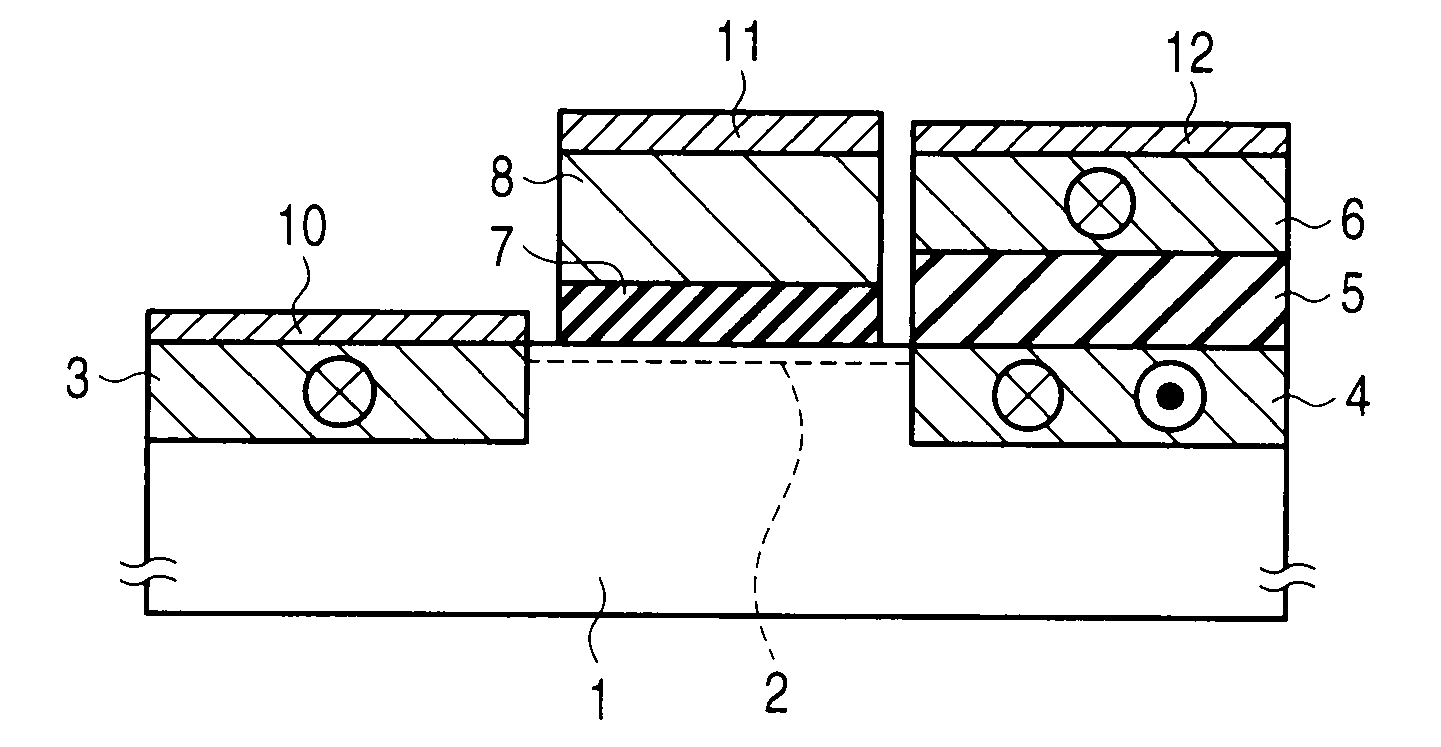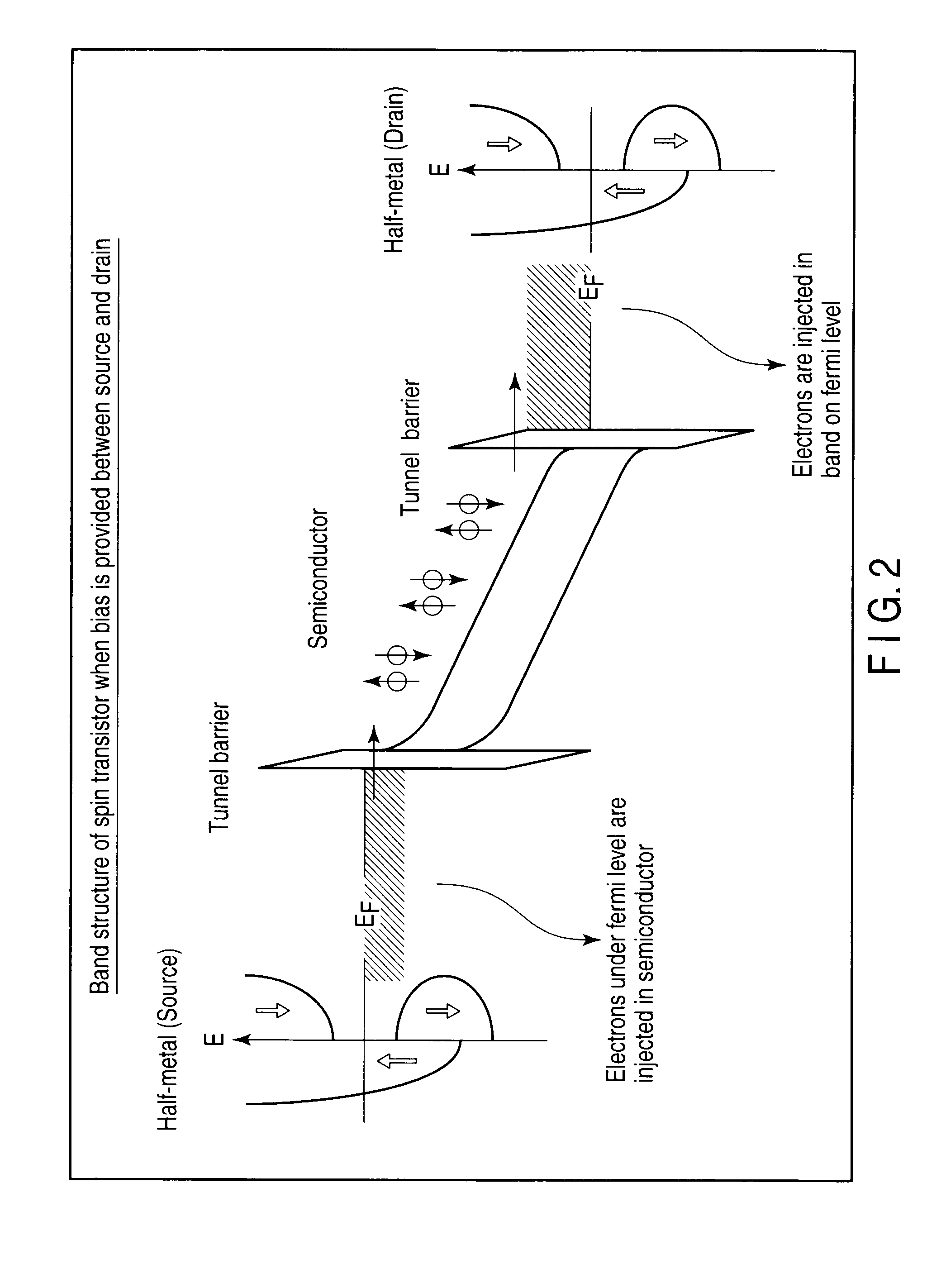Spin transistor, integrated circuit, and magnetic memory
a technology of integrated circuits and pin transistors, applied in semiconductor devices, digital storage, instruments, etc., can solve problems such as deterioration of idp/idap ratio
- Summary
- Abstract
- Description
- Claims
- Application Information
AI Technical Summary
Benefits of technology
Problems solved by technology
Method used
Image
Examples
first embodiment
(1) First Embodiment
[0124]FIG. 8 is a spin transistor according to a first embodiment of the invention.
[0125]The spin transistor of the first embodiment has the MOSFET structure.
[0126]Two recesses are made in a surface of a semiconductor substrate 1, one of the recesses is filled with a ferromagnetic layer 3, and another recess is filled with a ferromagnetic layer 4. A gate electrode 8 is formed on a channel 2 between the ferromagnetic layers 3 and 4 while a gate insulator 7 is interposed between the gate electrode 8 and the channel 2.
[0127]The ferromagnetic layer 3 is a magnetic pinned layer whose magnetization direction is invariable, and the ferromagnetic layer 4 is a magnetic free layer whose magnetization direction is variable. A ferromagnetic layer 6 is formed on the ferromagnetic layer 4 with a non-magnetic layer 5 interposed therebetween. The non-magnetic layer 5 may be either an insulating material or a conductive material. The ferromagnetic layer 6 is the magnetic pinned l...
second embodiment
(2) Second Embodiment
[0148]FIG. 9 is a spin transistor according to a second embodiment of the invention.
[0149]The spin transistor of the second embodiment has the J-FET structure or MESFET structure.
[0150]In the J-FET structure, the gate electrode 8 is made of a semiconductor, and the conduction type of the gate electrode 8 is opposite to the conduction type of the semiconductor substrate 1. In the MESFET structure, the gate electrode 8 is made of metal. In the MESFET structure, the semiconductor substrate 1 is mainly made of a compound semiconductor (such as GaAs, InP, and SiC), and a Schottky junction is formed by the semiconductor substrate 1 and the gate electrode 8.
[0151]Two recesses are made in the surface of the semiconductor substrate 1, one of the recesses is filled with the ferromagnetic layer 3, and the other recess is filled with the ferromagnetic layer 4. The gate electrode 8 is formed on the channel 2 between the ferromagnetic layers 3 and 4.
[0152]The ferromagnetic la...
third embodiment
(3) Third Embodiment
[0169]FIG. 10 is a spin transistor according to a third embodiment of the invention.
[0170]The spin transistor of the third embodiment has the MOSFET structure. The spin transistor of the third embodiment is a modification of the spin transistor of the first embodiment.
[0171]The spin transistor of the third embodiment differs from the spin transistor of the first embodiment in that an anti-ferromagnetic layer AF1 is disposed between the ferromagnetic layer 3 and electrode 10 while an anti-ferromagnetic layer AF2 is disposed between the ferromagnetic layer 6 and the electrode 12. The anti-ferromagnetic layers AF1 and AF2 are also called a pinned layer, and the anti-ferromagnetic layers AF1 and AF2 have functions of pinning the magnetization of the ferromagnetic layers 3 and 6 that are of the magnetic pinned layers.
[0172]Due to the existence of the anti-ferromagnetic layers AF1 and AF2, the magnetization directions of the ferromagnetic layers 3 and 6 are stabilized ...
PUM
 Login to View More
Login to View More Abstract
Description
Claims
Application Information
 Login to View More
Login to View More - R&D
- Intellectual Property
- Life Sciences
- Materials
- Tech Scout
- Unparalleled Data Quality
- Higher Quality Content
- 60% Fewer Hallucinations
Browse by: Latest US Patents, China's latest patents, Technical Efficacy Thesaurus, Application Domain, Technology Topic, Popular Technical Reports.
© 2025 PatSnap. All rights reserved.Legal|Privacy policy|Modern Slavery Act Transparency Statement|Sitemap|About US| Contact US: help@patsnap.com



